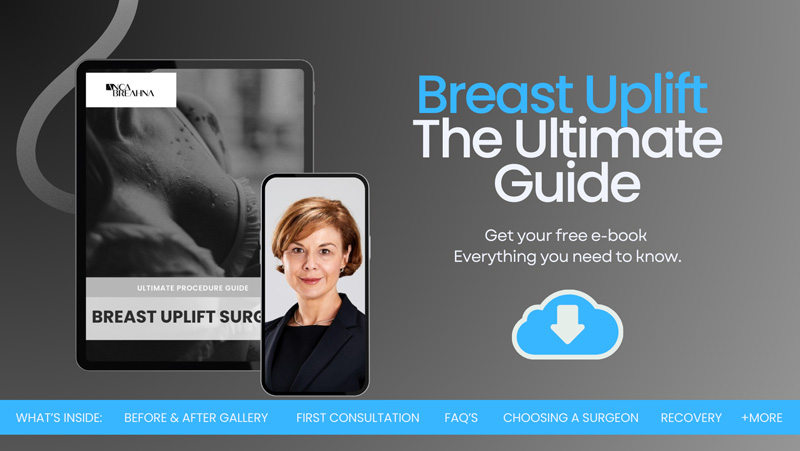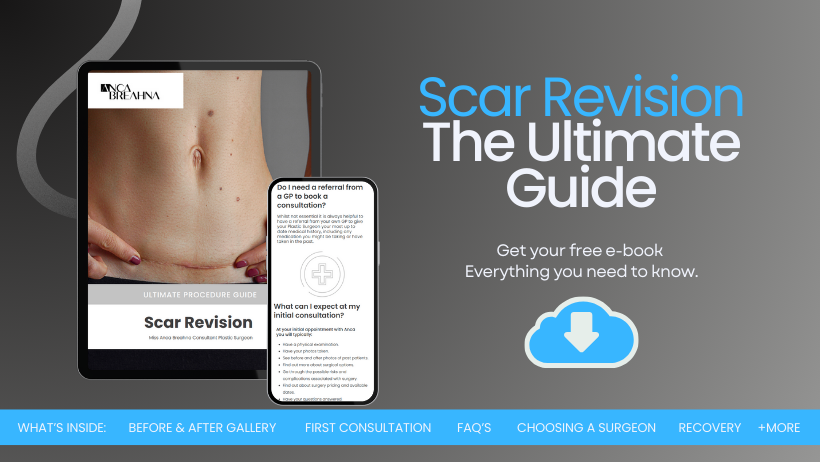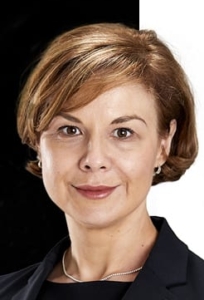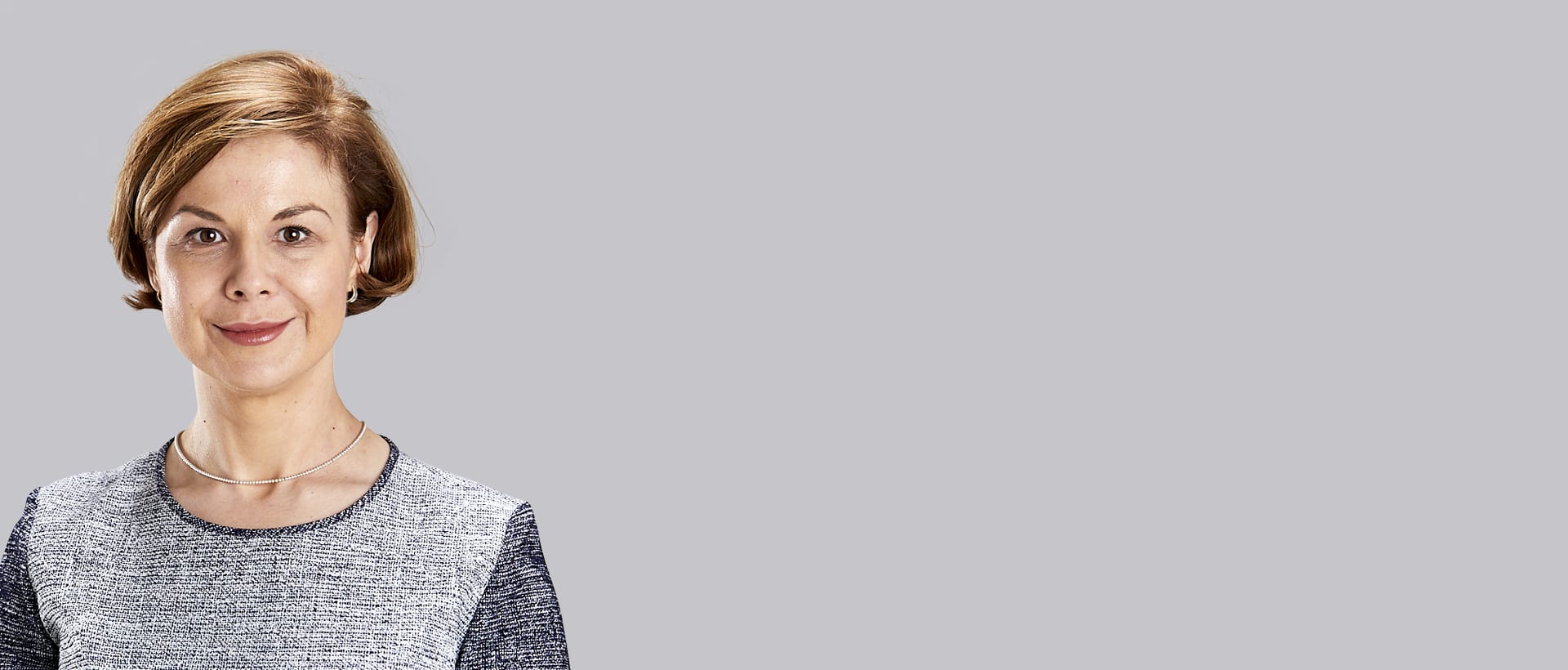
- Guide to Managing and Fading Breast Uplift Scars
- Download Anca's Breast Uplift Guide
- What Are Breast Uplift Scars?
- The Healing Process of Breast Uplift Scars
- Top Treatments to Reduce Breast Uplift Scars
- Silicone Sheeting and Gels
- Topical Creams and Gels
- Massage Therapy
- Home Remedies to Fade Breast Uplift Scars
- Download Miss Anca Breahna’s Scar Revision Guide
- Professional Medical Procedures for Fading Breast Uplift Scars
- How to Prevent Excessive Scarring from a Breast Uplift
- FAQs about Breast Uplift Scars
- How bad are the scars after breast uplift surgery?
- When do the scars from breast uplift turn white?
- Is breast uplift worth the scars?
- What happens if breast uplift incisions open?
- What can I do to avoid too much scarring after breast uplift?
- Further Reading about Breast Uplift Surgery with Consultant Plastic Surgeon Anca Breahna
- Medical References about Breast Lift Surgery
Guide to Managing and Fading Breast Uplift Scars
When you make the decision to enhance your body image with a breast uplift, it’s a memorable moment. You’re taking a step towards embracing your femininity and boosting your self-confidence. Yet, with this decision comes a natural concern about scars after breast uplift surgery.
In this blog, Chester Consultant Plastic Surgeon Anca Breahna aims to help you understand what to expect in terms of breast uplift scars and how to effectively manage and fade them.
In any surgical procedure, scars are an inevitable part of the healing process. A breast uplift, also known as mastopexy, is no exception. This procedure lifts and reshapes the breasts, giving them a firmer and more youthful appearance. But it involves incisions which eventually develop into scars. The severity and visibility of these scars can vary depending on factors such as your skin type, the surgical technique used, and how well you care for your wounds post-surgery.
Scarring can be a source of anxiety for many women considering a breast uplift. It’s important to remember that scarring is a natural response to injury or trauma to the skin. It’s the body’s way of healing. With the appropriate knowledge and care, these breast uplift scars can be effectively managed and faded over time.
Download Anca’s Breast Uplift Guide

What Are Breast Uplift Scars?
To effectively manage and reduce breast uplift scars, you first need to understand what they are and why they form. When the skin is damaged, your body works to repair the wound. As part of this healing process, your body produces a protein called collagen. This collagen forms a network of fibers across the wound, creating a scar.
Breast Uplift scars form along the incision lines made during surgery. The most common types of scars following a breast uplift are hypertrophic scars, keloid scars, and atrophic scars. Hypertrophic scars are raised and red, but they don’t extend beyond the boundary of the original wound. Keloid scars, on the other hand, are also raised and red but can grow larger than the original wound. Atrophic scars are sunken or pitted due to the loss of fat or muscle under the skin.
The appearance and severity of breast uplift scars can vary widely among individuals. Factors such as genetics, age, skin type, and even lifestyle habits can influence how your scars form and fade.
The Healing Process of Breast Uplift Scars
The healing process of breast uplift scars is a complex and dynamic process that occurs over several stages. The first stage is inflammation, where your body responds to the injury by increasing blood flow to the area. This leads to redness, warmth, and swelling. During this stage, it’s essential to keep the wound clean to prevent infection.
The second stage is the proliferative phase, which involves the formation of new tissue and blood vessels. This is when collagen is produced, forming the initial scar tissue. The scar at this stage is usually red and raised.
The final stage is remodelling, where the scar matures and becomes more refined. This can take several months to years. The scar gradually becomes lighter, flatter, and less noticeable. During this stage, various treatments can be used to help reduce the visibility of the scar and improve its appearance.
Top Treatments to Reduce Breast Uplift Scars
The process of scar reduction involves a combination of professional treatments and home care strategies. While some degree of scarring is inevitable following a breast lift, advances in treatment options have made it possible to significantly lessen their appearance.
Silicone Sheeting and Gels
Silicone sheeting and gels are amongst the first things that come to mind when talking about scar management, especially in post-surgical scenarios like breast uplifts. This method is highly recommended by plastic surgeons due to its proven effectiveness in scar reduction. Silicone products work by creating a protective barrier over the scar, which maintains hydration and allows the skin to perform its natural healing processes more efficiently. This hydration helps to reduce the scar’s thickness, and as a result, its colour and texture are improved, making it less conspicuous.
The application of silicone sheeting or gel begins once the wound has fully healed and the scar has entered the remodelling phase, which is when the body is actively repairing and reshaping the scar tissue. Consistent use over several months is often required for optimal results. The ease of use and minimal risk of side effects make silicone-based treatments a preferred choice for many patients.
Topical Creams and Gels
Another effective approach to minimise scarring involves the use of topical creams and gels formulated with specific ingredients known for their scar-reducing properties. Ingredients such as onion extract and vitamin E are popular for their ability to soften and flatten scars. These components work synergistically to diminish redness and promote the healing process, thereby improving the overall appearance of the scar.
For best results, these topical treatments should be applied consistently over a period of several months. The continuous application helps to ensure that the scar tissue receives ongoing treatment, which is crucial for significant improvement. It’s important to select products that are specifically designed for scar treatment, as they contain the right concentrations of active ingredients to be effective.
Massage Therapy
Incorporating massage into the scar management routine can also yield beneficial results. Massaging the scarred area can help to break down the dense, fibrous scar tissue, which can make the scar less raised and more flexible. Improved circulation from the massage promotes healing and may also stimulate the production of collagen, a key protein in skin elasticity and regeneration. This can lead to scars becoming smoother and less noticeable over time.
Massage therapy for scar reduction should be performed gently and with care to avoid causing any irritation to the healing tissue. It’s often recommended to use a moisturising oil or cream to facilitate the massage and provide additional hydration to the skin.
Home Remedies to Fade Breast Uplift Scars
In addition to medical treatments, there are several home remedies that can help fade breast uplift scars. One of the simplest ways is to protect the scar from the sun. Sun exposure can darken scars and slow the healing process. Therefore, always apply a broad-spectrum sunscreen to your scars when going outdoors.
Natural oils such as coconut, rosehip, and vitamin E oil can also help fade scars. These oils are rich in vitamins and fatty acids that nourish the skin, promoting healing and reducing scar visibility. They should be massaged into the scar daily for best results.
Another effective home remedy is aloe vera. Known for its healing properties, aloe vera can help reduce inflammation and promote skin regeneration, helping to fade scars over time.
Download Miss Anca Breahna’s Scar Revision Guide

Professional Medical Procedures for Fading Breast Uplift Scars
For stubborn or severe scars, there are professional medical procedures available.
- Laser therapy is one of the most effective methods for reducing the appearance of scars. It works by using light energy to break down scar tissue and stimulate the growth of new, healthy skin cells
- Steroid injections can also be used to treat raised scars such as keloids and hypertrophic scars. These injections work by reducing inflammation and slowing the production of collagen, which can help flatten and soften the scar
- Surgical revision is an option for extreme cases. This procedure involves removing the scar tissue and re-closing the wound in a way that’s more likely to heal with a less noticeable scar. However, this should be considered as a last resort, as it involves additional surgery and recovery time
How to Prevent Excessive Scarring from a Breast Uplift
While scarring from a breast uplift is inevitable, there are measures you can take to prevent excessive scarring. One of the most important is to follow Anca’s post-operative care instructions closely. This includes keeping the wound clean, avoiding strenuous activities that could strain the incision sites, and refraining from smoking, which can delay healing.
Eating a balanced diet rich in protein, vitamins, and minerals can also aid in wound healing and scar formation. Staying hydrated and getting adequate sleep can further support your body’s healing process.
Once the wound has healed, start implementing scar management strategies such as silicone sheeting, massage, and sun protection. These measures can help minimise the visibility of your scars and improve the overall outcome of your breast uplift.
It’s natural to have concerns about scarring following a breast uplift. But with a good understanding of the healing process and appropriate scar management strategies, you can effectively manage and reduce your breast lift scars. Always consult Anca if you have any concerns or questions about your healing process.
FAQs about Breast Uplift Scars
How bad are the scars after breast uplift surgery?
- The severity of scars after breast uplift surgery can vary widely depending on several factors, including the surgical technique used, the individual’s skin type, the ability to heal, and the post-operative care received. Anca will do her best to place incisions in less visible areas, such as around the areola, vertically down from the areola to the breast crease, and sometimes horizontally along the breast crease, to minimise the appearance of scars. While modern surgical techniques aim to reduce scarring, patients should expect some level of visible marks. Initially, scars may appear red and raised but fade over time to become less noticeable. Following post-operative care instructions meticulously and employing recommended scar-minimisation treatments can affect the final appearance of scars.
When do the scars from breast uplift turn white?
- The process of scars turning white, known as scar maturation, can vary greatly among patients but generally occurs within several months to a year or more after surgery. The initial red or dark appearance of scars gradually fades to pink and then to a paler, more flesh-toned colour as the scar matures. This transition happens as the blood flow to the area decreases and the body completes the healing process. The exact timing depends on multiple factors. Consistent care and treatment of the scar can help speed up this process, but patience is key, as complete maturation can take a significant amount of time.
Is breast uplift worth the scars?
- For many individuals, the benefits of a breast uplift—such as improved breast shape, position, and overall appearance—outweigh the concern of scars. The decision to proceed with a breast uplift surgery should consider the potential for scarring against the expected improvements in self-confidence, body image, and comfort. Most patients find the trade-off acceptable, especially when considering that scars fade over time and can be minimised with proper care. Consulting with a qualified plastic surgeon can provide clarity by setting realistic expectations and discussing the techniques used to reduce scarring. Ultimately, the value of the procedure is a highly personal decision that depends on individual goals and perspectives on body image.
What happens if breast uplift incisions open?
- If breast uplift incisions open, it’s essential to seek immediate medical attention to prevent infection and ensure proper healing. Open incisions can occur due to various reasons, including excessive movement, pressure on the surgical area, or inadequate wound care. Anca will assess the situation and may need to clean the wound, prescribe antibiotics to prevent infection, and possibly re-suture the incision if necessary. Following post-operative instructions closely, including restrictions on activity and proper wound care, is crucial to prevent incision opening and promote healing. Keeping the area clean, dry, and protected helps support the recovery process and minimises complications.
What can I do to avoid too much scarring after breast uplift?
To avoid excessive scarring after a breast uplift, it’s important to follow a care plan both before and after surgery. Main strategies include:
- Choosing a skilled surgeon: Experienced surgeons not only employ techniques that minimise scarring but also provide precise post-operative care instructions
- Following post-operative care instructions: Adhering to your surgeon’s guidelines regarding wound care, activity restrictions, and follow-up appointments is crucial
- Avoiding smoking: Smoking impairs healing and can significantly worsen scarring
- Maintaining a healthy diet: Proper nutrition supports the body’s healing process
- Applying recommended treatments: Use silicone sheets or gels, and apply prescribed topical creams to promote scar healing and reduce visibility
- Protecting scars from the sun: UV exposure can darken scars, so covering them or using a high-SPF sunscreen is essential
- Gentle massage: Once approved by your surgeon, massaging the scarred area can help soften and flatten the scar tissue
Further Reading about Breast Uplift Surgery with Consultant Plastic Surgeon Anca Breahna
- Read more about Recovery Timeline after Breast Uplift (Mastopexy) Surgery
- Read more about How to Fix Saggy Breasts – Breast Uplift, Breast Implants or Both
- Read more about What Are the Benefits of a Breast Lift with Implants?
- Read more about How to Get Firmer Breasts
- Read more about Breasts after Weight Loss
- Read more about Solutions for Saggy Breasts
- Read more about Solutions for Uneven Breasts
- Read more about Top 10 Strategies to Reduce Bruising After Breast Uplift Surgery
- Read more about Treating, Reducing and Minimising Plastic Surgery Scars
- Read more about Breast Lift and Nipple Sensitivity
Medical References about Breast Lift Surgery
- Breast lift – Mayo Clinic
- Scar Prevention by Laser Treatment in Mastopexy With Implant
- Patient-reported Outcomes of Scar Impact: Comparing of Abdominoplasty, Breast Surgery, and Facial Surgery Patients
- Acupuncture and dry needling for physical therapy of scar
- Breast Reduction Scars: Healing, Appearance & Treatment – Cleveland Clinic


 Ms Anca Breahna, PhD, MSc, FEBOPRAS, FRCS (Plast) is a highly regarded Consultant Plastic Surgeon specialising in the field of Aesthetic and Reconstructive Plastic Surgery. Anca performs a range of
Ms Anca Breahna, PhD, MSc, FEBOPRAS, FRCS (Plast) is a highly regarded Consultant Plastic Surgeon specialising in the field of Aesthetic and Reconstructive Plastic Surgery. Anca performs a range of 